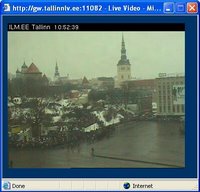Thursday, February 23, 2006
Independence day
 Tomorrow marks one of these rare Estonian official holidays: independence day ("Aastapäev" in Estonian, which, literally translated, means "year day"). Aastapäev is the national holiday of Estonia; explaining that is more difficult than it seems...
Tomorrow marks one of these rare Estonian official holidays: independence day ("Aastapäev" in Estonian, which, literally translated, means "year day"). Aastapäev is the national holiday of Estonia; explaining that is more difficult than it seems...The independence day to be remembered, February 24th, 1918, was just that - one day of independence. Before that, Bolshevists ruled, but they quickly scattered before the Germans, who were still marching strong in the beginning of 1918. Hence the one day: the Germans took over the land almost instantly. If it is of interest to you (and if you remember your history lessons): these events are followed by the Treaty of Brest-Litovsk, the treaty forced upon the Russians by the Germans on March 3rd, 1918. Under the conditions of that treaty, only Saaremaa (the big island in the West) became German whilst the rest of the country became Russian (in the mean time there was some struggle between White-Russians and Bolsheviks, so I might be a bit inaccurate here). In reality however, the Russians retreated much further, leaving the whole of Estonia under German rule.
Of course, as we know the war was coming to a close by then. Less known however is that the armistice of 1918 wasn't followed by disarmament of the Germans in the Baltics. Accomplishing that took some British intervention, which is why the autonomy of Estonia was accepted by Germany only on November 19th, 1918.
 There comes the Estonian republic, one would think. Wrong again - by that time the Soviets were on the move again, occupying about 75% of the territory by December 1918. Estonia then - under general Laidoner and with British aid - fought back rather heroically, and managed to kick out the Soviets and the collaborating Latvian Riflemen by the time the new republic could celebrate its first year of independence. The first civil government followed a bit later, somewhere in 1920. So far for our "short history of Estonian independence". There is much more to tell, but this is a blog and not a history book...*
There comes the Estonian republic, one would think. Wrong again - by that time the Soviets were on the move again, occupying about 75% of the territory by December 1918. Estonia then - under general Laidoner and with British aid - fought back rather heroically, and managed to kick out the Soviets and the collaborating Latvian Riflemen by the time the new republic could celebrate its first year of independence. The first civil government followed a bit later, somewhere in 1920. So far for our "short history of Estonian independence". There is much more to tell, but this is a blog and not a history book...*Just that there is also a "re-independence day" which takes place on August 20th, 1991, but which is not celebrated as a national holiday (the day is known though as the day on which the president traditionally opens up his rose garden).
The national holiday in Estonia is quite an event, celebrated with medals, rewards and cake in the offices. The day before, most offices close after lunch; the day itself is e free day here (which is not very common in Estonia, compared to Belgium). With any luck, you might be able to catch a glimpse of the "military parade" that takes place on and around the freedom square (look in the left corner of this image from 9:50 local time onwards).
 This year might offer an extra treat: Kristina Smigun (foto: yahoo! news), the best Estonian cross-country skier and winner of two gold medals these winter games, will be racing for gold over 30 kms tomorrow (12:30 local time). Let's see if there is gold to be celebrated this time...
This year might offer an extra treat: Kristina Smigun (foto: yahoo! news), the best Estonian cross-country skier and winner of two gold medals these winter games, will be racing for gold over 30 kms tomorrow (12:30 local time). Let's see if there is gold to be celebrated this time...* Just for clarification: Estonia became autonomous once before in March 1917 under the Kerenski regime, but lost it again soon after the Bolsheviks took power during the October revolution. The importance of that short period is that the Estonian "government" managed to send out several diplomatic missions during that time, which later on proved crucial in securing international support for the young republic...